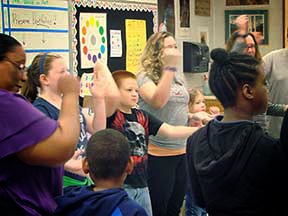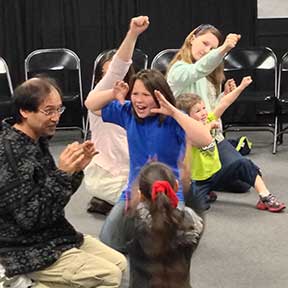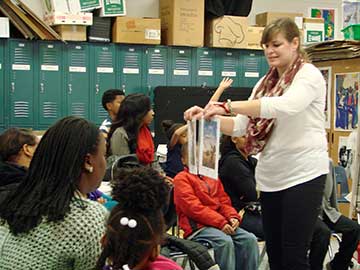CommuniCreate - Background and Rationale

Engaging families in K-12 arts education has the potential to overcome barriers to parent involvement in schools (Catterall, Dumais, & Hampden-Thompson, 2012). Froiland, Peterson, & Davison (2013) indicate that students are more likely to succeed academically when their parents, regardless of background, experiences, and socio-economic status, are actively engaged in their education. Despite these findings, many K-12 schools struggle to effectively partner with their parent community, especially when it comes to reinforcing learning goals and objectives in the home (Henderson & Mapp, 2002). Reasons why parents are not actively involved in their child’s education include the belief that teaching should be left to those with content-specific expertise (Green, Walker, & Hoover-Dempsey, 2007), whichis problematic because parental involvement is an influential factor in student academic performance (Henderson & Mapp, 2002).
Schools with arts programs have found innovative ways to help parents better engage in their children’s academic career. Examples include providing opportunities for families to create works of art with their children, guiding parents and students through learning experiences in the arts, and exhibiting student artwork and/or sharing student performances during after-school events (Barnes, 2010; Catterall, Dumais, & Hampden-Thompson, 2012). Parental involvement and access to the arts in schools impacts student achievement as evidenced by attendance, academic performance, and high school graduation rates (Catterall, Dumais, & Hampden-Thompson, 2012).
The Arts-Based Collaborative considered how these findings could help schools across Hamilton County better partner with their parent communities while reinforcing the value of arts education. Currently, Hamilton County Department of Education has identified needs in regards to both increasing access to arts education across K-12 schools and strengthening parental involvement (Hamilton Department of Education, 2012; Imagine Chattanooga 20/20, 2011). Through the process of developing CommuniCREATE in partnership with Barger Academy of Fine Arts, we can better understand how parental involvement is impacted through increasing opportunities in arts learning for students and their families.
References
Barnes, J. (2010). The GENERATE project: Curricular and pedagogical inspiration from patens and their children working together. Improving Schools, 13(2), 143-157, doi: 10/1177/1365480210376477
Catterall, J. S., Dumais, S. A., & Hampden-Thompson, G. (2012). The arts and achievement in at-risk youth: Findings from four longitudinal studies. Washington, DC: National Endowment for the Arts.
Froiland, J. M., Peterson, A., & Davison, M. L. (2013). The long-term effects of early parent involvement and parent expectation in the USA. School Psychology International, 34(1), 33-50. doi: 10.1177/0143034312454361
Hamilton County Department of Education. (2012). Family Engagement Plan. (PDF document). Retrieved from: http://www.hcde.org/Download.aspL=2&LMID=630330&PN=DocumentUploads
DivisionID=14285&DepartmentID=15178&SubDepartmentID=&SubP=
Act=Download&T=1&I=275975
Imagine Chattanooga 20/20. (2011). Strengthening the Region through Creativity, Arts & Culture. (2011). (PDF document). Retrieved from http://alliedartschattanooga.org/site/media/AA_ChattReport_0127F_MeduimRes.pdf
Henderson, A. T., & Mapp, K. L. (2002). A new wave of evidence: The impact of school, family, and community connections on student achievement. Austin, TX: National Center for Family and Community Connections with Schools.
Richerme, L.K., Schuler, S.C., McCaffrey, M., Hansen, D., & Tuttle, L. (2012). Promoting universal access to high-quality arts education: Roles of certified arts educators, certified non-arts educators, & providers of supplemental arts instruction. Dover, DE: State Education Agency Directors of Arts Education.





